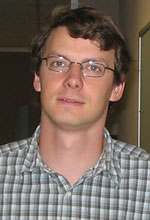
Research Assistant Professor
Department of Computer Science
University of North Carolina at Chapel Hill
Tel: (919) 962 1703
Fax: (919) 962 1699
E-mail: jmf@cs.unc.edu
 |
Jan-Michael Frahm Research Assistant Professor Department of Computer Science University of North Carolina at Chapel Hill Tel: (919) 962 1703 Fax: (919) 962 1699 E-mail: jmf@cs.unc.edu |
| Home |
Research |
Publications |
Curriculum |
Tutorials & Workshops |